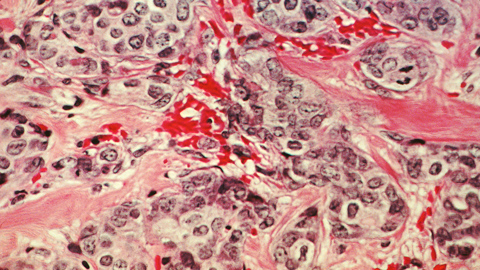Cancer Stiffness Controls Growth of Malignant Cells
Cancer induces stiffening of the surrounding tissue, which in turn accelerates the growth of the cancer cells. This creates a proliferation inducing vicious cycle. Researchers at the University of Turku have made a significant discovery which affects the direction of future cancer research.

Many cancer patients begin their journey when they find a "lump". New research results reveal that the "lump" has a significant role in the malignancy of the cancer. Increased tissue stiffness initiates a comprehensive change in the cancer cells. The change leads to a systemic increase in the expression of growth promoting genes, describes Academy Professor Johanna Ivaska.
Ivaska's research team working at the University of Turku has been studying the mechanosensitivity of normal and tumour tissue. Mechanosensitivity means the cells' ability to sense the stiffness of their surrounding tissue. Many of the human tissues, such as breast tissue, are very soft, and the cells of the tissue have been optimised to grow normally in that specific environment. The cell adhesion receptors, called integrins, transmit signals about the tissue's softness into the cell's nucleus and control cellular responses to stiffness via multiple mechanisms.
– New research results prove for the first time that the firmness of the cancerous tumour affects the epigenetic regulation of gene expression and increases the malignancy of the cancer. In a laboratory environment, we were able to stop the cancer growth simply by restoring the stiffness of the cancer's surrounding tissue to match a normal soft breast tissue.
Research results of Research Fellow Riina Kaukonen revealed to the researcher group that increased tissue stiffness induced translocation of an epigenetic enzyme, (JMJD1A) from the cytoplasm to the nucleus and enabled JMJD1A to alter cancer gene expression comprehensively and increased cell growth.
By removing the JMJD1A enzyme, Kaukonen was able to prevent the growth of various cancer types in vitro and their ability to form cancerous tumours in vivo. In collaboration with doctors from Turku and Helsinki University Hospitals, researchers also discovered that level of JMJD1A expression was higher in cancers where the tumour's surrounding tissue displayed markers of higher density.
– Research results provide a completely new perspective to the role of the tumour's surrounding tissue in the development of the cancer. With therapeutic targeting of the interaction of cancer cells with their surrounding tissue, in addition to treating cancer cells, we might significantly improve the efficacy of current therapies in the future.
Research results have been published in the esteemed Nature Communications journal of the cell biology field on 4 August 2016. http://www.nature.com/articles/ncomms12237
Text: Johanna Ivaska, Erja Hyytiäinen
Photo: NIH Image Gallery
Translation: Johanna Ivaska, Saara Yli-Kauhaluoma